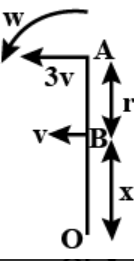
Two points of a rod move with velocities 3 v & v perpendicular to the rod and in the same direction, separated by a distance 'r'. The angular velocity of rod is:
A. $\omega = \dfrac{{3v}}{r}$
B. $\omega = \dfrac{{4v}}{r}$
C. $\omega = \dfrac{{5v}}{r}$
D. $\omega = \dfrac{{2v}}{r}$
Answer
216.6k+ views
Hint: We must apply the angular velocity formula in order to answer this question. Let's first discuss angular velocity, the vector measure of rotation rate, which describes the rate at which an item rotates or revolves in relation to another point.
Formula used:
$v = r\omega $
Complete answer:
A rotating object's point continually changes direction, making it challenging to determine the angular velocity direction. The rotating object's axis is the only location where its direction is fixed. The Right Hand Rule is used to identify the direction of angular velocity using the axis of rotation.

In the given diagram we can see that the upper point of the rod A is moving with velocity 3v which is perpendicular to the rod. Also, at point B the velocity is given v perpendicular to rod. Let us assume the distance between point A and the point B is r and the distance between point B and point O is x. Hence, the total length of rod will be r+x,
Let us assume the angular velocity of rod about the point O is$\omega $. Formula we will use will be
$v = r\omega $
For point A we can write the equation as,
$3v = \left(r + x\right)\omega $-----(1)
Also, for point B we can write as
$v = x\omega $--------(2)
Now, subtracting equation 2 from 1 we get,
$2v = r\omega $
$ \Rightarrow \omega = \dfrac{{2v}}{r}$
Hence, option D is correct.
Note: The obtained linear velocity turns out to be proportional to the radius of the rotating particle's circle. Every single particle in a revolving body has the same angular velocity. We may deduce the relationship between any other linear and rotational variable from this relationship. For instance, the radius times the angular acceleration is also equal to the linear acceleration.
Formula used:
$v = r\omega $
Complete answer:
A rotating object's point continually changes direction, making it challenging to determine the angular velocity direction. The rotating object's axis is the only location where its direction is fixed. The Right Hand Rule is used to identify the direction of angular velocity using the axis of rotation.

In the given diagram we can see that the upper point of the rod A is moving with velocity 3v which is perpendicular to the rod. Also, at point B the velocity is given v perpendicular to rod. Let us assume the distance between point A and the point B is r and the distance between point B and point O is x. Hence, the total length of rod will be r+x,
Let us assume the angular velocity of rod about the point O is$\omega $. Formula we will use will be
$v = r\omega $
For point A we can write the equation as,
$3v = \left(r + x\right)\omega $-----(1)
Also, for point B we can write as
$v = x\omega $--------(2)
Now, subtracting equation 2 from 1 we get,
$2v = r\omega $
$ \Rightarrow \omega = \dfrac{{2v}}{r}$
Hence, option D is correct.
Note: The obtained linear velocity turns out to be proportional to the radius of the rotating particle's circle. Every single particle in a revolving body has the same angular velocity. We may deduce the relationship between any other linear and rotational variable from this relationship. For instance, the radius times the angular acceleration is also equal to the linear acceleration.
Recently Updated Pages
JEE Atomic Structure and Chemical Bonding important Concepts and Tips

JEE Amino Acids and Peptides Important Concepts and Tips for Exam Preparation

Electricity and Magnetism Explained: Key Concepts & Applications

Chemical Properties of Hydrogen - Important Concepts for JEE Exam Preparation

JEE Energetics Important Concepts and Tips for Exam Preparation

JEE Isolation, Preparation and Properties of Non-metals Important Concepts and Tips for Exam Preparation

Trending doubts
JEE Main 2026: Application Form Open, Exam Dates, Syllabus, Eligibility & Question Papers

Derivation of Equation of Trajectory Explained for Students

Hybridisation in Chemistry – Concept, Types & Applications

Understanding the Angle of Deviation in a Prism

Understanding Collisions: Types and Examples for Students

How to Convert a Galvanometer into an Ammeter or Voltmeter

Other Pages
JEE Advanced Marks vs Ranks 2025: Understanding Category-wise Qualifying Marks and Previous Year Cut-offs

Units And Measurements Class 11 Physics Chapter 1 CBSE Notes - 2025-26

NCERT Solutions For Class 11 Physics Chapter 8 Mechanical Properties Of Solids

Motion in a Straight Line Class 11 Physics Chapter 2 CBSE Notes - 2025-26

NCERT Solutions for Class 11 Physics Chapter 7 Gravitation 2025-26

Understanding Atomic Structure for Beginners




